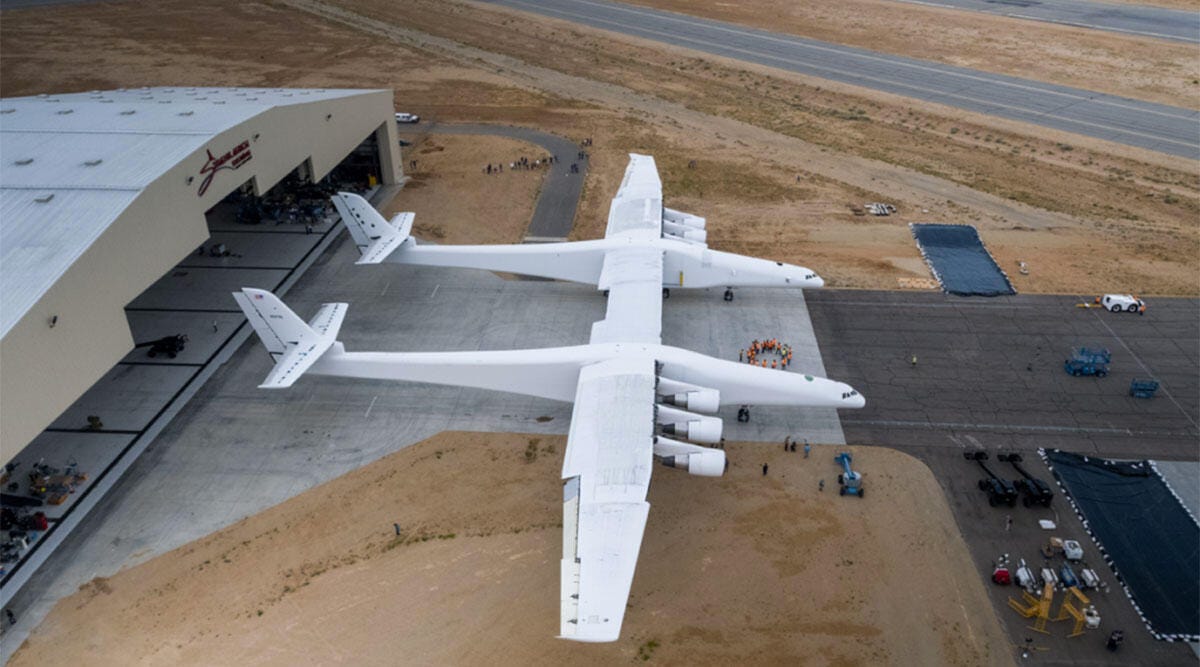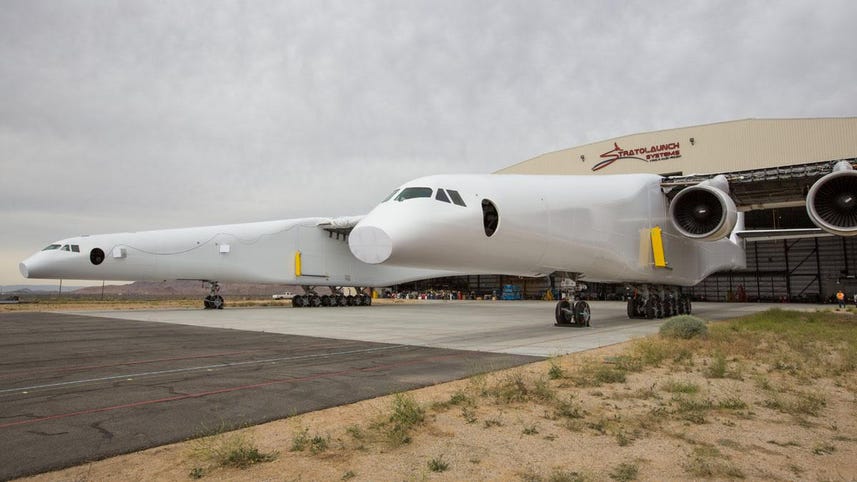Meet the Stratolaunch, the world's largest airplane
This oddball Frankenstein plane, invented by Microsoft co-founder Paul Allen, is designed to launch rockets into space.

Rolling out a new world record
This is the Stratolaunch. With a wingspan of 385 feet, the special plane is now the largest in the world. Don't expect to see it at your local airport though. This craft has a more important purpose than transporting people: It launches hypersonic rockets.
Why is everyone talking about this plane, which just got a brand new owner? Take a closer look at it, and you'll soon see for yourself...
This is one gigantic plane
By the numbers, the Stratolaunch -- code name "Roc" -- is the largest plane ever built. Its wings measure 385 feet across, longer than a professional football field. Its twin fuselages are 238 feet long, while its tail height is 50 feet.
As such, it had to be constructed here at the Mojave Air and Space Port, inside a specially constructed 88,000-square-foot hangar.
Celebrating the first-ever launch
A decent-size crowd made the early morning trek to the Mojave Desert to watch, and celebrate, the first ever launch of the Stratolaunch on April 13, 2019.
Soaring over the Mojave
The Stratolaunch's pilots climbed to 17,000 feet to test the craft's performance and handling, doing a number of aerial maneuvers.
It's big, but it sure isn't fast
The Stratolaunch achieved a top speed of 189 mph during its first flight.
Pushing the Stratolaunch to its limits
In addition to performing roll doublets, yawing maneuvers, pushovers, pull-ups and steady-heading slideslips, the Stratolaunch pilots simulated landing-approach exercises.
Touchdown!
The Stratolaunch touched down after roughly 2.5 hours of flight.
Stratolaunch: Mission Accomplished
"We all know Paul would have been proud to witness today's historic achievement," said Jody Allen, trustee of the Paul G. Allen Trust. "The aircraft is a remarkable engineering achievement."
Next up: The Stratolaunch's first-ever rocket launch
Of course, there are many milestones yet for the Stratolaunch to achieve.
"Stratolaunch is exploring the development of aerospace vehicles and technologies, including the needs for reliable, routine access to space," Stratolaunch spokesman Art Pettigrue told SpaceNews. "This exploration inlcudes the need to significantly advance the nation's ability to design and operate hypersonic vehicles."
Testing the engines for the first time
On Sept. 19, 2017, the Stratolaunch successfully completed a series of important engine tests, with all six Pratt & Whitney turbofan engines performing as expected.
Stratolaunch has passed all its tests with flying colors so far
The Stratolaunch has also completed fuel testing, along with testing of its electrical, pneumatic and fire-detection systems.
The Stratolaunch concept
The Stratolaunch has yet to launch its first rocket, but this concept photo shows what that might look like.
If you look between the two fuselages, you'll see three rockets designed to launch into space.
How the Stratolaunch launches rockets
This graphic shows possible operation of the Stratolaunch. The plane first carries a rocket to an altitude of roughly 35,000 feet. The rocket then separates from the plane and engages its own engines to continue its climb.
It can launch up to 3 rockets per flight
For its first launch, the Stratolaunch will likely carry a single Pegasus XL rocket, built by Orbital ATK. The craft is designed, however, to carry as many as three of these between its twin fuselages.
A bicipital airplane
No, you're not seeing double -- the Stratolaunch really is a two-headed airplane. But only the cockpit on the starboard (right when facing forward) fuselage is manned.
No one's home on the port side, though
The port side cockpit, meanwhile, is designed to stay empty and unpressurized.
A plane this heavy needs lots of wheels
With a max takeoff weight of 1.3 million pounds (650 tons), the Stratolaunch needs a lot of support from its 28 wheels.
There are 12 main landing-gear wheels and two nose-gear wheels on each side.
A Boeing 747-400 to be harvested for parts
Many of the systems of the Stratolaunch were borrowed from Boeing 747-400 planes in the most literal sense. Engineers cannibalized the engines, avionics, flight decks and landing gear of two such planes during the building process, including the one shown here.
This is what the Stratolaunch's cockpit looks like
This is the inside of a Boeing 747-400, showing you what the cockpit of the Stratolaunch looks like. The record-breaking plane is designed to operate under a three-person crew: the pilot, co-pilot and flight engineer.
During the building process
Once the Stratolaunch has proved itself in testing, the craft is expected to participate in six to 10 missions per year.
The beginnings of the Stratolaunch
Here's a wide shot of the massive Stratolaunch Systems hangar from 2015. In this photo, you can take a barest-of-bones look at the early days of the plane's construction.
Meet Paul Allen, the man originally behind the plane
This is Microsoft co-founder Paul Allen. He and Scaled Composites founder Burt Rutan created Stratolaunch Systems on Dec. 13, 2011, to develop a new air-launch-to-orbit system that could revolutionize space transportation.
Fulfilling his life's dream
When you're the sole financier of a plane, you're allowed to climb this high for a photo op.
"It is a big initial fixed investment to get this going," Allen said when announcing the project in 2011. "But you have a certain number of dreams in your life that you want to fulfill, and this is a dream that I'm very excited about seeing come to fruition."
Stratolaunch: Under new ownership
Following the death of founder Paul Allen, Stratolaunch was sold to Cerberus Capital Management, a private equity fund, in October 2019.
According to new Stratolaunch CEO Jean Floyd, the company's mission is "to be the world's leading provider of high-speed flight test services."
Stratolaunch: A company on the grow
There's no question that Stratolaunch is ramping up its efforts. Jean Floyd announced in December 2019 that the company had grown from 13 to 87 employees in two months' time.
Meet the Hyper-Z
A paper presented at the American Institute of Aeronautics and Astronautics Space 2018 conference detailed Stratolaunch's interest in air launching hypersonic experimental vehicles, such as the Mach 10 Hyper-Z, seen here.
Under old ownership, Stratolaunch discontinued development of the Hyper-Z in early 2019. In February 2020, Stratolaunch spokesperson Art Pettigrue told CNET that the Hyper-Z "may, or may not, reflect our future direction."
The future is in hypersonic vehicles
"Stratolaunch is exploring the development of aerospace vehicles and technologies, including the need for reliable, routine access to space," Pettigrue told SpaceNews in January 2020. "This exploration includes the need to significantly advance the nation's ability to design and operate hypersonic vehicles."
Monitoring the build progress
Here, Allen and his team check the progress on the Stratolaunch prior to officially unveiling it.
The rear view
Here's a look at the rear of the Stratolaunch.
There are 6 powerful engines...
The Stratolaunch is powered by six 250 kN (56,000 lbf) Pratt & Whitney PW4056 engines harvested from the Boeing 747-400s.
This plane needs a LOT of runway
Because of its immense size and weight, the Stratolaunch needs 12,000 feet of runway -- nearly 2 miles' worth -- to take off.
A quick look under the plane
Here's a look at the underside of the Stratolaunch while in its Mojave Desert hangar.
The first step toward flight
"We have removed the fabrication infrastructure, including the three-story scaffolding surrounding the aircraft, and rested the aircraft's full weight on its 28 wheels for the first time," said Stratolaunch Systems CEO Jean Floyd. "This was a crucial step in preparing the aircraft for ground testing, engine runs, taxi tests and, ultimately, first flight."

World's largest aircraft gets ready to fly
The massive Stratolaunch leaves its hangar for the first time to start new rounds of testing.
Launching rockets; launching innovations
Allen's motivations for building and financing the Stratolaunch were made clear in a 2016 statement.
"When such access to space is routine, innovation will accelerate in ways beyond what we can currently imagine," he wrote. "That's the thing about new platforms: when they become easily available, convenient and affordable, they attract and enable other visionaries and entrepreneurs to realize more new concepts."
A Stratolaunch class photo
Allen and the Stratolaunch Systems team pose for a photo near one of the plane's two tails.
Welcome to America's first Space Port
The Stratolaunch is being tested at the Mojave Air and Space Port, located in California's Mojave desert. It's the first facility to be licensed by the Federal Aviation Administration as a "spaceport" to support reusable spacecraft.
A visit to the Mojave Space Port
Of course, the Stratolaunch isn't the only strange private spacecraft at the Mojave Space Port. Check out the Rotary Rocket, an odd private launch vehicle from the late 1990s that was powered by a helicopter-like rotary blade. It made three successful hover flights in 1999.
The Rotary Rocket Company ultimately ran out of funds and was abandoned in 2001.
Paul Allen's first spaceship
This is neither Rutan's (left) nor Allen's first attempt at creating a commercially viable aircraft. The duo teamed up over a decade ago to build SpaceShipOne at the Mojave Space Port, the first privately built and piloted reusable vehicle to reach space.
That ship is now on display at the National Air and Space Museum in Washington, D.C.
SpaceShipOne: A prize-winning craft
On October 4, 2004, SpaceShipOne climbed to a record altitude of 377,591 feet (71.5 miles) and clinched the $10 million Ansari X Prize, awarded to the first private team to reach space.
Development costs of the craft were $25 million, fronted entirely by Allen.

